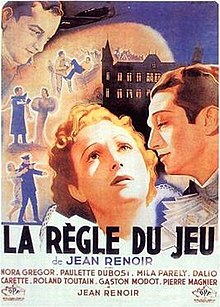| The Rules of the Game | |
|---|---|
 Theatrical release poster | |
| Directed by | Jean Renoir |
| Written by |
|
| Produced by | Claude Renoir |
| Starring | |
| Cinematography | Jean Bachelet |
| Edited by |
|
| Music by | |
Production company | Nouvelle Édition Française |
| Distributed by | Gaumont Film Company |
Release date |
|
Running time | 110 minutes |
| Country | France |
| Language | French |
| Budget | 5,500,500 francs |
The Rules of the Game (original French title: La règle du jeu) is a 1939 French satirical comedy-drama film directed by Jean Renoir. The ensemble cast includes Nora Gregor, Paulette Dubost, Mila Parély, Marcel Dalio, Julien Carette, Roland Toutain, Gaston Modot, Pierre Magnier and Renoir.
Renoir's portrayal of the wise, mournful Octave anchors the fatalistic mood of this pensive comedy of manners. The film depicts members of upper-class French society and their servants just before the beginning of World War II, showing their moral callousness on the eve of destruction.
At the time, The Rules of the Game was the most expensive French film made: Its original budget of 2.5 million francs eventually increased to more than 5 million francs. Renoir and cinematographer Jean Bachelet made extensive use of deep-focus and long shots during which the camera is constantly moving, sophisticated cinematic techniques in 1939.
Renoir's career in France was at its pinnacle in 1939 and The Rules of the Game was eagerly anticipated. However, its premiere was met with scorn and disapproval by critics and audiences. Renoir reduced the film's running time from 113 minutes to 85, but even then, the film was a critical and financial disaster. In October 1939, it was banned by the wartime French government for "having an undesirable influence over the young".[1]
For many years, the 85-minute version was the only one available; even so, its reputation slowly grew. However, in 1956, boxes of original material were discovered, and a reconstructed version of the film premiered that year at the Venice Film Festival, with only a minor scene from Renoir's first cut missing. Since then, The Rules of the Game has been called one of the greatest films in the history of cinema. Numerous film critics and directors have praised it highly, citing it as an inspiration for their own work. It is the only film to earn a place among the top ten films in the respected Sight & Sound (British Film Institute) decennial critics' poll for every decade from the poll's inception in 1952 through the 2012 list (in 2022 it fell to #13).[2][3][4][5][6][7][8]
- ^ Drazin 2011, p. 186.
- ^ "Sight & Sound Top Ten Poll: 1952". bfi.org.uk. British Film Institute. Archived from the original on October 8, 2014. Retrieved June 8, 2014.
- ^ "Sight & Sound Top Ten Poll: 1962". bfi.org.uk. British Film Institute. Archived from the original on October 8, 2014. Retrieved June 8, 2014.
- ^ "Sight & Sound Top Ten Poll: 1972". bfi.org.uk. British Film Institute. Archived from the original on October 8, 2014. Retrieved June 8, 2014.
- ^ "Sight & Sound Top Ten Poll: 1982". bfi.org.uk. British Film Institute. Archived from the original on October 8, 2014. Retrieved June 8, 2014.
- ^ "Sight & Sound Top Ten Poll: 1992". bfi.org.uk. British Film Institute. Archived from the original on October 8, 2014. Retrieved June 8, 2014.
- ^ "Sight & Sound Top Ten Poll: 2002". bfi.org.uk. British Film Institute. Archived from the original on October 7, 2014. Retrieved June 8, 2014.
- ^ "Critics Top Ten". bfi.org.uk. British Film Institute. Archived from the original on February 7, 2016. Retrieved August 16, 2020.